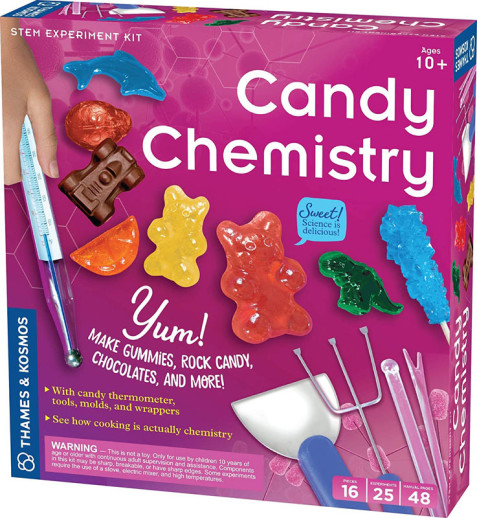We use cookies to make your experience better. To comply with the new e-Privacy directive, we need to ask for your consent to set the cookies. Learn more.
Candy Chemistry Science Kit | Thames and Kosmos
I don't know very many people who would turn down an opportunity to fit candy into their curriculum, and cooking and baking is an awesome way to learn about chemistry. This kit gives you instructions to learn about transfer of heat, volume, phases of matter, freezing and melting point, boiling and condensation, crystallization, solutions, chemical reactions, and more. The kit includes special tools, molds for chocolate and gummy candies, cutters, paper baking cups, lollipop sticks, candy thermometer, colored foil sheets, and candy labels. Use this kit along with your own ingredients to make chocolate shapes and lollipops that look like cars, ladybugs, Santa or a bunny; make gummy dolphins, berries, dinosaurs, bats, bears, and fruit slices; or make a solid chocolate egg to give as a gift. The molds are hard plastic and are high quality like those used by confectioners, and the dipping fork and sugar spatula are great specialty tools. The experiment manual includes recipes, explanations, and colored illustrations. This is a great kit for learning chemistry and introducing candy making to your children. ~ Donna
Explore chemistry as you cook up candies and chocolates in the kitchen! Perform a number of sweet experiments and learn important physical science principles related to candy and cooking. Discover why sugar crystallizes to make rock candy. Learn about specific heat and the phases of matter by molding chocolates. Use a thermometer and learn about heat and temperature while boiling sugar. Gain experience with measurements and conversions, volumes, and weights. Investigate the chemistry of gummy bears. Learn about the mysterious phenomenon of triboluminescence with wintergreen candies. Make gummy candies, chocolate shapes, and hard sugar candy using the special tools included: plastic and metal molds, candy thermometer, spatula, dipping fork, and more. Finish them with foils, paper cups, sticks, and wrappers. The 48-page, full-color manual provides instructions and explanations. Does not contain hazardous chemicals or food items; you supply the safe ingredients from your kitchen.
| Product Format: | Kit |
|---|---|
| Brand: | Thames and Kosmos |
| Grades: | 4-AD |
| EAN/UPC: | 814743010185 |
| Length in Inches: | 11.75 |
| Width in Inches: | 11.25 |
| Height in Inches: | 2.625 |
| Weight in Pounds: | 0.9 |

